
Programming note: I have decided to include the category banner at the top of each post, even though they introduce a moment of redundancy, since I like the design (mine) and I don’t think they’re seen often enough; previously they were seen only at the tops of Category pages (linked on the right side of the homepage). Let me know if you think they’re too intrusive.
It’s time for another entry in FNY’s Cross Streets of NYC series…
I’ve done them piecemeal in the past, but I’ve already posted 20th Street, 21st Street, 22nd Street, 17th Street, 10th Street, 6th Street, 18th Street and 25th Street in this batch, and 14th Street as well in autumn 2019 with more to follow. Before the Great Infection, I spent a number of Saturdays (and some Sundays too) crisscrossing Manhattan via its numbered streets. Over the years, I’ve done this quite a few times and I was amazed at how much stuff I missed and how much material I knew about and posted here and there, but never really formalized or categorized. Eventually I might make these “crosstown” posts their own separate category. In late summer, I resumed the crosstown walks.
On a hot August afternoon I walked 26th Street from west to east. 26th runs from 12th Avenue to the FDR Drive without interruption; it is of course divided into West and East sections by 5th Avenue, and house numbers emanate from the Queen of Avenues. I exited the A train at 8th Avenue and headed east: thus, I am using Google Street View for everything between 8th and 12th Avenues.
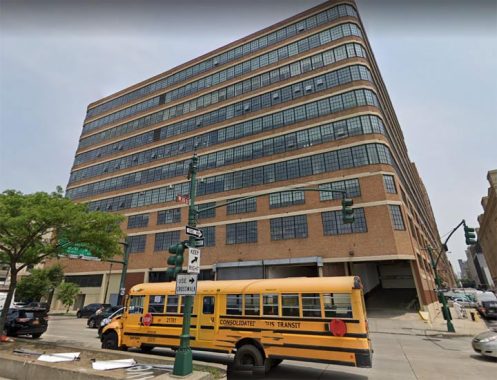
The Starrett-Lehigh Building is huge freight terminal and warehouse occupying an entire block from 26th-27th Streets and 11th and 12th Avenues completed in 1932. It was jointly built by the Lehigh Valley RR and the Starrett Corporation (William Starrett, the builder of the Empire State Building, was called “the founder of the American skyscraper.”) The Lehigh Valley Railroad could once enter the building, with its cars accessing floors via elevator (trucks use them now). Traces of carfloats and tracks can still be seen at the waterfront. This building is a forerunner of the International Style glass walled design popular later in the century.

This building on the other side of West 26th Street is identified by a plaque above the entrance as the Manhattan Borough Repair Shop of the NYC Department of Sanitation. It sits on the old Lehigh RR trainyard and appears to have been first constructed in the Moderne 1930s (see Comments), with renovations in subsequent decades that seem echoic of the Starrett Lehigh Building.
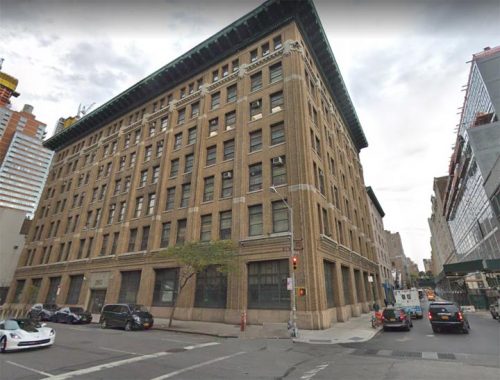
Skipping ahead to 11th Avenue, here’s #260 11th, the Otis Elevator Building constructed in 1912 as the company’s factory. Here, elevators used in the Woolworth Tower, Chrysler Building, Empire State Building and World Trade Center as well as the Willis (Sears) Tower in Chicago were constructed, before the company moved out in 1974. The building was later home to Chippendale’s, the nightclub with the famed male dance troupe. (Info: NY Songlines)

I wish I knew more about this massive storage building at 11th Avenue and West 26th, catercorner from the Otis Elevator Building and across the street from the Starrett Lehigh Building.
B&O’s freight terminal office/warehouse building (see Comments)
From the late 1800s until the 1930s, a freight railroad ran down the center of 11th Avenue; it was replaced by the West Side Freight Elevated, now High Line Park (see below).

I am intrigued by this pair of peaked-roofed brick buildings at #537-547 West 26th. They are marked as “Iron Works” on old maps and by 1940, they were home to the manufacturers of Fruehauf Trailers. Today the buildings are studios of the Cedar Lake modern ballet corps.

The West Side Freight RR was built to replace the 11th Avenue grade railroad in the 1930s and remained in operation until 1980; beginning in 2006, it was renovated piecemeal into a high-concept linear park that opened in sections between 2009 and 2019. It’s a Forgotten NY favorite: here’s a link to FNY’s many pages on the structure. A new entrance was opened on West 26th Street in 2009.
In recent years, the High Line has come under fire for spurring the hypergentrification of Chelsea, with longtime businesses and tenants driven out by spiking rents and prices.
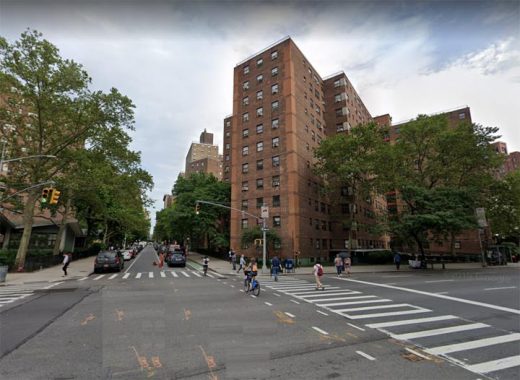
The blocks between West 24th and 28th Streets and 9th-10th Avenues are dominated by “towers in the park” complexes like the Elliott Houses (above) Chelsea Houses and Penn Station South (Penn South) Houses, opened in 1962. All were constructed as part of a massive slum clearance movement.

The Manor Community Church, 348 West 26th between 8th and 9th Avenues, is the last trace of what the “slum clearance” blocks once looked like. When the chapel was built in 1874, this part of Chelsea was home to gambling dens, saloons and houses of prostitution. The church was constructed in a Flemish Revival style popular at the time with differently-shaped parapets and gables. The Manor Church had been established in 1852 as an outreach of the Marble Collegiate Church on 5th Avenue. Currently, its food pantry is much in demand by the area needy.

And now, a bit of nostalgia. I went to a trade school in Chelsea on West 26th between 6th and 7th, the Center for the Media Arts, from 1990-1992 and worked as a part time typesetter there from 1992 until the school closed in 1993 after a failed merger with Mercy College. This Gristedes’ supermarket and tennis bubble were there at the corner of West 26th and 8th during my tenure as was the McDonalds next door. All the while, I was employed as a typesetter/proofreader at a small shop on West 29th called ANY Phototype. Beginning in 1992, I got a job in Port Washington with Publishers Clearing House, and had to travel from Port Washington to Chelsea several nights a week. I was living in Bay Ridge, so the subway/LIRR fares added up.
The tennis bubble is also the former home of the Upright Citizens Brigade comedy group in the former Maverick Theater, now the Improv Asylum.
The north side of West 26th between 7th and 8th has a number of walkup residential buildings that are still the bread and butter of Manhattan residential buildings. #241 West 26th dates from the days when parking garages could still be built along pleasingly esthetic lines.

The New York Auction Company building at #226 West 26th, titled with the “V of Importance,” is the former home of my old school, Center for the Media Arts. Here I learned software like Adobe Photoshop and Illustrator as well as page composition software QuarkXpress. All confused me at first (like WordPress, which I use to make Forgotten NY) but there were generous lab hours and I sat in front of screens for hours, self-teaching. The goods auctioned here were furs.

Directly across the street from the former school/fur auction house is Chelsea Television Studios, which is actually a modified armory constructed in 1914. Fairly early on, film producer Adolph Zukor rebuilt it into a movie studio for his Famous Players company. In the 1950s two soundstages were built, and parts of several well-known films were shot here including Twelve Angry Men with Henry Fonda, BUtterfield 8 with Elizabeth Taylor, and the Mel Brooks farce The Producers; and TV soaps like As The World Turns and Guiding Light; as well as network fare like The Patty Duke Show. In recent decades it has become a TV talk studio staple; for example, when I was attending CMA, Ricki Lake taped her talk show here, and presently Wendy Williams holds forth with celebrity gossip.
Fashion Institute of Technology (FIT) is a collegiate institute founded in 1944, associated with the State University of New York, offering a 4-year graduate program with special emphasis on the fashion industry; it’s located between West 26th and 28th between 7th and 8th Avenues, toward the south end of NYC’s Garment District. The Brutalist-style buildings [De Young & Moscowitz arch.], constructed in 1977, consist of the Fred Pomeranz Art and Design Center, David Dubinsky Student Center, a dormitory center, and the Center for Design Innovation. The Museum at FIT is open to the public (planning to reopen in fall 2020).

Older maps ID this 12 story loft building at #151-163 West 26th as The Fabian Building.
As proof you can find anything you want in NYC, here’s Rock Star Crystals at 146 West 26th. Their Yellow Pages online listing describes them thusly:
Rock Shop and Gemstone Metaphysical Store in the heart of Manhattan with New York City’s best collection of crystals, fine minerals and mineral specimens from around the world. Over 140 different minerals including quartz. Amethyst. Rose quartz. Citrine. Tourmaline. Agate and more. Clusters. Geodes and items CUT from gemstones including quartz balls. Quartz spheres. Pyramids. Pendulums. Gemstone beads. Tumbled stones. Obelisks. Bookends. Gemstone hearts. Massage wands. And jewelry. Healing crystals and crystals for FENG SHUI and REIKI. Great source for jewelry supplies for making custom jewelry. We also carry fossils. Meteorites. MOLDOVITE. Tectites. And shells.

The Helen Mills event space at #137 West 26th Street offers 4000 square feet of space for “a variety of corporate, social, non-profit and arts-related events, including meetings & conferences, product launches, bar/bat mitzvahs, fundraisers and many other celebrations.”
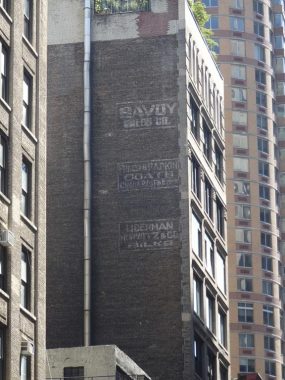
At 111 West 26th we find a number of painted ads for long-ago Garment District businesses. As usual, I turn to The Indispensable Walter Grutchfield at 14 to 42; recently, Walter donated his photo collection, consisting of hundreds of painted ad photos, to my associated organization, Greater Astoria Historical Society.
Savoy Dress was located at 109 West 26th for 5 years, 1919-1924; Freed & Rapkin Coats, for a few year from 1918 to the mid-1920s; and Liberman Horwitz & Co., Silks from 1918-1924. I’ve always considered it ironically amazing that these businesses, active for so short a time in an ever-changing maufacturing landscape, are preserved for decades before the sun finally decided to bleach them out of existence. Similar ads can be found on nearly every side street in the Garment District.

I like this sign for Digital Cleaners in green, gold and white, with the sanserif Avant Garde font, at 107 West 26th, but I have no idea what computers have to do with dry cleaning. I imagine the owners thought it was a spiffy sounding name. Note the barber pole next door. These days, red, white and blue revolving barber poles are usually mounted on buildings, but if you look at old archival photos, they were frequently free-standing on the sidewalk outside the shop.

I took this shot of the former Fidelity Building, #101 West 26th at 6th Avenue, since it’s one of the few older buildings remaining on 6th between about 25th and 33rd Streets; the 1990s and 2000s saw a building boom in which several buildings dating from the 1880s-1920s were torn down in favor of high rise residential behemoths.
Another pair of painted ad-bedecked loft builings on West 26th, on either side of 6th Avenue; for details, consult the above linked 14 to 42 site by Walter Grutchfield.
I dug the detailing of this incredible building at #29 West 26th from the columns on the 3rd to 5th floors to the “Von Hoffman” above the entrance. According to another fella I find “indispensable,” Tom Miller at Daytonian in Manhattan, Von Hoffman Arms was built in 1893 as a residence by Margaretta Todd (née Von Hoffman) in a Renaissance Revival style [George Keister, arch.] The building was located in the occasionally dodgy Tenderloin District in the 1890s, yet Todd had no trouble locating tenants. In 1905, Margaretta Todd was murdered in Philadelphia, yet $20,000 of diamonds were found with the remains. The murder was never solved. Over time as the Garment District overspread the Tenderloin, the Von Hoffman’s residences were turned into manufacturing lofts.
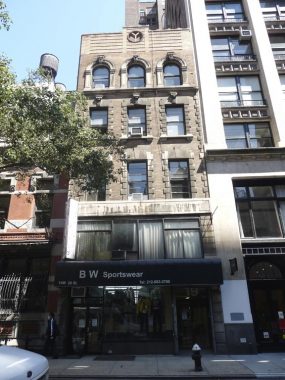
Nearby, #19 West 26th has an unusual brick “Y” cutout at the top that reminds me of the die cut “Y” that was found on subway tokens from 1953-1980, part of the “NYC” logotype. Unfortunately I don’t know its significance.
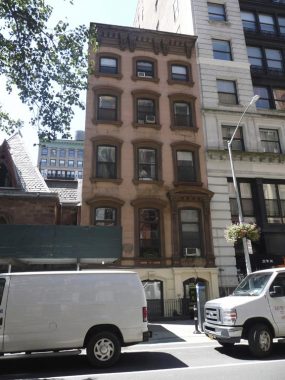
Parked trucks make building photography difficult, but I got just enough of #20 West 26th, I think. It appears on the right side of the back edge of the Cathedral of St. Sava on West 25th, constructed from 1850-1855 as an uptown chapel of Trinity Church and designed by Richard Upjohn; it was sold Serbian Eastern Orthodox parish in 1942. The church nearly burned down in 2016, but the parish has stabilized the structure and is in a slow rebuilding process.
As for the walkup itself, it was built in the 1870s and was briefly acquired by Trinity for its Boys’ Club in 1912. From the 1920s to the 1950s the building was used for manufacturing until it became residences again in 1956. [info: Daytonian in Manhattan, again]
Across the street are a pair of interesting-looking Federal style brick buildings with terracotta and granite highlights. They were built in 1881 as counting houses by brothers William Waldorf and John Jacob Astor III. A plaque identifies #21 as “Writers’ House,” a literary agency that sponsored authors such as Erica Jong (“Fear of Flying”) and Neil Gaiman (DC Comics’ Sandman series). One of the Astors married millionaire Communist (a contradiction, no?) Corliss Lamont, and thus, #23 became at one time the national HQ of the United States Communist Party and offices for its newspaper The Daily Worker. The offices were bombed several times between 1964 and 1972.
Interior views of #21 at the Writers’ House website

Looking south, Broadway and West 26th. Between Houston Street and Central Park, Broadway is the only major diagonal route in Manhattan, dating from the precolonial era when it was a trail used by Native Americans. Formerly a busy auto route, it is today largely given over to pedestrian plazas and bicycle lanes, as recent administrative changes and traffic regulations have not favored motorists.

The building on the SW corner (at left) is the former site of Delmonico’s restaurant. The present 21-story building went up in 1913. Amazon honcho Jeff Bezos owns the top three floors. Above is a view from the 5th Avenue side.
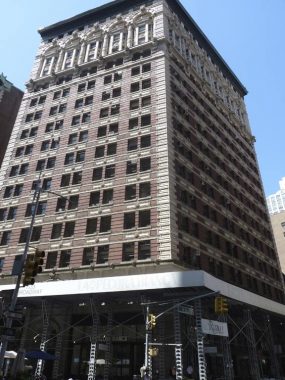
The multicolor brick St. James Building on the SW corner of West 26th Street and 1133 Broadway dates to 1897 and is marked by its 3-story arcade along the roofline. The corner features prominent stone quoining on the corner. The large circular window above the front door is called an oculus, after the Latin for “eye.” Daniel Burnham, who built the Fuller (Flatiron) Building 3 blocks south, assisted in the design. It replaced the earlier St. James Hotel, which Confederate terrorists attempted to burn down in 1864.
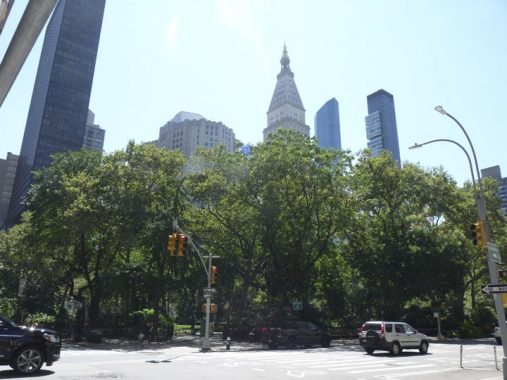
East 26th Street forms the northern border of Madison Square Park. The 41 story Merchandise Mart on Madison looms at left.
Like Washington Square, Madison Square was once a potter’s field and a military march drilling field on the edge of town. In the early 1800s, there were roadhouses and armories in the general region where Bloomingdale Road (Broadway) continued a northwest run on Manhattan Island at 5th Avenue, which reached this far north in the 1820s, and the vanished Eastern Post Road ran northeast. The post road was closed in 1844 and the new Madison Square opened as a public park three years later.
Quickly Madison Square developed as a prime residential era, and the Fifth Avenue hotel and the original Madison Square Garden (Originally an 1870s railroad passenger depot leased to PT Barnum that first gained its name in 1879; the second on the site was built by famed architect Stanford White, who was shot dead on the Garden’s rooftop by jealous husband Harry Thaw) surrounding it. The arm and torch of the Statue of Liberty were exhibited in the park (1876-1882) prior to its 1886 installation on Bedloe’s Island, and the first electric street lighting in NYC was illuminated here (1880). A graveyard of one, the repose of Mexican-American General William Jenkins Worth, is located in the triangle formed ny Broadway, 5th Avenue and West 25th Street, flanking the park.
Madison Square was also the site of the city’s first experimentation with lawn chairs (1901; a failure); the site of the first public Christmas tree (1912), a tradition under fire by cultural exclusionists in recent years. In the 20th Century tall office towers began ringing the park, most notably the Metropolitan Life Insurance Building and Fuller (Flatiron) Building, and in 2009, the 60-story One Madison Park residential tower (by Rem Koolhaas — a great name for an architect).
Statuary in the park features an array of eclectic personalities: Abraham Lincoln’s Secretary of State William Seward, who arranged the purchase of Alaska from Russia; U.S. Senator Roscoe Conkling; Admiral David Farragut; and President Chester Alan Arthur.
In 2012 I did a round robin walk of the five major squares in midtown Manhattan.

Looking north toward the King of All Buildings on 5th Avenue and 26th Street. The unusually named Croisic Building is seen under construction netting at left. It was named for Richard de Logerot, Marquis de Croisic, aristocrat and hotelier; the Croisic Hotel formerly stood on the site. When not scaffolded, the exterior features gargoyles and eagles.

The Hotel Giraffe, a boutique hotel named for its long, lean profile, occupies the NE corner of Park Avenue South and East 26th. In the 1940s the plot was occupied by the much shorter Hotel Elton.
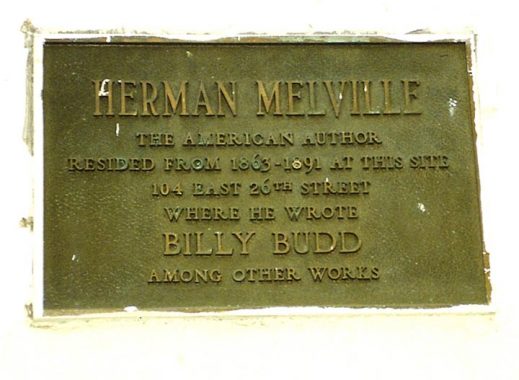
Blink and you’ll miss this small plaque marking the residence of famed American author Herman Melville (1819-1891), who resided at the house then at #104 East 26th Street in the last decades of his life. Melville was born at #6 Pearl Street downtown, and pursued an adventurous life at sea while a young man. He finally moved to NYC with his family for good in 1863. Melville worked downtown as a deputy inspector of customs, and wrote Billy Budd while he lived here; though the short story “Bartleby the Scrivener” is set in Manhattan it wasn’t written in the borough.
A sign on the light pole in front of the Hotel Giraffe marks this as Herman Melville Square.
The “Fighting 69th” regiment of the US Army, a part of the NY Army National Guard, was founded in 1849 and has had a rich history in the US Civil War and Word War I and up to today; the unit has fought in the Iraq War. Between 1917 and 1992 it was also designated as the 165th Infantry Regiment, and its headquarters are still located at the 69th Regiment Armory at #68 Lexington Avenue fronting the entire avenue between East 25th and 26th Streets. A substantial memorial to the “Fighting 69th” is found in Calvary Cemetery in Queens.
In its early days the regiment consisted nearly completely of Irish immigrants. Its motto, “Gentle when stroked – fierce when provoked” refers to the representations of Irish wolfhounds found on the regiment’s crest and dress cap badges in the 1860s. In some ceremonies, the regiment’s officers and senior non-commissioned officers carry shillelaghs as a badge of rank.
The armory, built from 1904-1906 by the architectural firm of Hunt and Hunt, does not resemble the uptown, Brooklyn, Bronx and Staten Island armories constructed in the 1800s. They were built on the model of medieval-style fortresses, while Hunt and Hunt went for a then-contemporary Beaux-Arts look, even adding a French Second Empire-style mansard roof, originally popular in the 1870s.
Between 1917 and 1992 the “Fighting 69th”was also designated as the 165th Infantry Regiment, which has been chiseled above the front entrance. Though the Guard is still HQ’ed here, the Armory has been put to an amazing number of uses over the years:
–Indoor marathons beginning in 1910
–As early as 1913 art shows were presented here, including the International Exhibition of Modern Art Armory Show, where Marcel Duchamp’s “Nude Descending a Staircase” was first shown
–Roller derby in the 1940s
–NBA NY Knickerbocker games from 1946-1960, after which the Knicks moved to the uptown Madison Square Garden at 8th avenue and West 50th Street
–Lingerie-clad lovelies pranced at Victoria’s Secret shows intermittently from 2003-2013
–The annual NY Record Fair used to be here (I attended a couple of years until it moved to much smaller quarters on West 18th Street)
–Numerous art exhibits continue to be held
Names of prominent battles of the Civil War and WWI are inscribed on the 25th and 26th Street ends, using the “V of importance.”

East 26th begins to assume a different aspect as you ease into the Rose Hill neighborhood, with curbside trees and attached walkup residences. These face the Armory across the street.
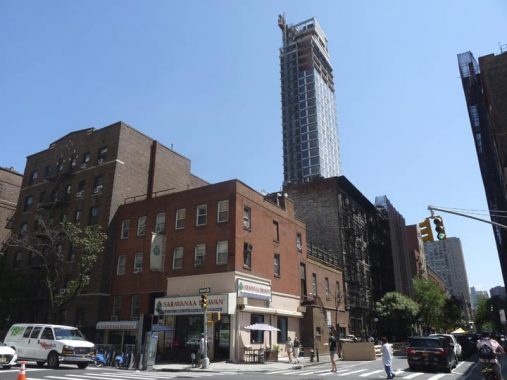
The 35-flight, 400-foot tall VU New York, a luxury high rise, looms over the corner of Lexington Avenue and East 26th. City Realty shows expected views from the upper floors.

Amalgamated Industrial and Toy & Novelty Workers of America Local 223, #147 East 26th. The area north of Madison Square between Broadway and 3rd once had a number of toy and novelty manufacturers.
This ancient lamp stanchion illuminates the corner of East 26th and… Broadway Alley.
Broadway Alley is approximately five blocks east of the actual Broadway, which is the longest street in Manhattan and the Bronx. There is speculation that along the way, it acquired the name because local property owners wanted to impart a gay, (in the ‘upbeat’ sense of the word) theatrical aura to the place. However, as you might expect, in its almost 2-century history, it has been home to prostitution and crime. It was once lined on its east side with stables and tenement houses. A story holds that the Barnum and Bailey Circus had kept their elephants in the alley at one time.
About halfway down the alley going south, the pavement cuts off and the remainder is dirt road, with concrete chips and the occasional weed. There are some signs of remaining Belgian block pavement, and the alley likely once had those along its whole length. A metal fence with barbed wire protects 3rd Avenue business from any miscreants tempted to do a break-in. The rears of some 3rd Avenue buildings extend all the way to the alley, but #8 is the only building that faces Broadway Alley.
I used to be able to walk down the alley’s entire length, past its only address, #8, but today most of it is fenced off despite its supposedly public domain.

I am again at a loss about this handsome brick building, whose red bricks are a nice contrast to the yellow trim of Street Taco. I would like to see its neon sign lit up at night.
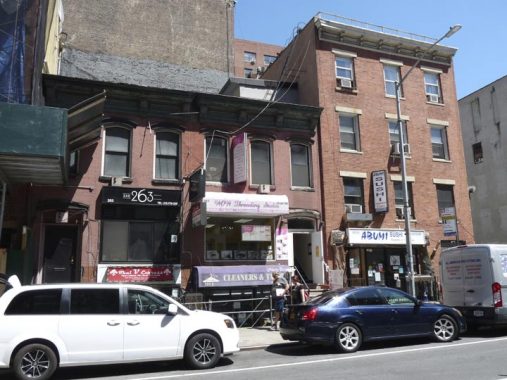
Were it not for the garish awning signs, these walkup buildings would look the same as they did in the 1920s or perhaps earlier.
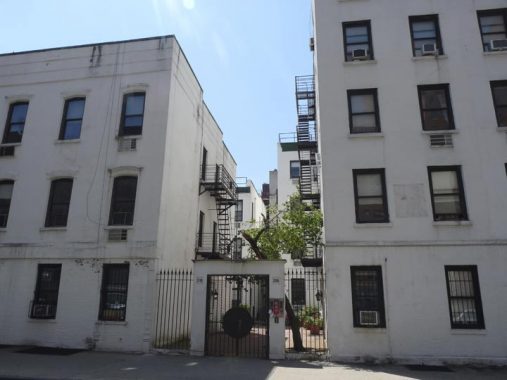
206-210 East 26th is an apartment complex constructed unusually for Manhattan: you enter through a gate and the entrances are on either side of the courtyard. This arrangement is commoner in Brooklyn or Queens.
Classic exterior residential sampler, East 26th between 2nd and 3rd Avenues.
On the east side of Bellevue South Park between 1st and 2nd Avenues we find a short, two-block street called Mount Carmel Place. This street harks back to a Forgotten NY experience. I seemed to recall a church facing the north end of the Place on East 28th Street in the late 1990s when I first started canvassing streets to scout the website. Indeed a church did stand there: the Our Lady of the Scapular Church, established by the Carmelite religious order, in 1889; the church, as well as its accompanying priory, were razed in favor of the Berkley Apartments, which went up in 2000.
The church, and its priory, played a role in the Irish independence movement of the late 1910s and early 2000s: smuggled Thompson machine guns were hidden in the priory, bound for the old sod, before they were seized by the US Government; and revolutionary Eamon de Valera (born in NYC but emigrated to Ireland with an uncle at age two), later the prime minister and even later president of Ireland (until age ninety!), sought refuge in the church in 1921.
The Carmelite order were chaplains at Bellevue Hospital from 1889 through 2007. Only this short Place remains of the legacy of the Carmelite order, the Carmelite church, and their service there.

The Bellevue Hospital complex on 1st Avenue is deeply rooted in NYC lore and legacy as the place where drunks were brought from late night binges. In an era when hospitals are shutting all over town, it’s one of the few full-service hospitals remaining in lower Manhattan, especially with the shuttering of Greenwich Village’s St. Vincent’s in 2010.
The original hospital opened as an almshouse in 1736 on the lot now occupied by City Hall. In 1811, New York City purchased Belle Vue farms, which [was] located at 27th Street and 1st Avenue. The land became the Bellevue Institution, in effect, a community center with an almshouse, a pesthouse, a soap factory, a greenhouse, a penitentiary, a school, a morgue, a bakehouse, an icehouse, and a shop for carpenters and blacksmiths. The institution was dedicated in its entirety in 1816.
Bellevue had already established a reputation for innovative medical technology by the mid-1800s, and treated soldiers from both the Civil War and the Spanish American War. Bellevue doctors pioneered the use of hypodermic syringes (1856), performed the nation’s first cesarean section (1867), and developed the first hospital-based ambulance service (1869). Specialized units holding 2,700 total beds, a variety of outpatient clinics, and four schools were founded as the hospital expanded. During World War I and II, Bellevue organized hospital units to serve overseas. Today, the hospital is affiliated with the New York University School of Medicine. NYC Parks
The tall building in the background is the office of NYC’s Chief Medical Examiner and Forensics Lab. If you were murdered, you may end up here.
Had enough 26th Street? How about 27th?
Check out the ForgottenBook, take a look at the gift shop, and as always, “comment…as you see fit.”
9/13/20

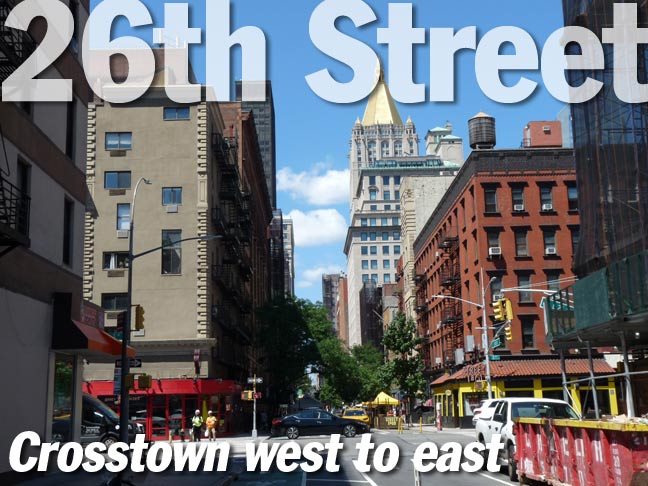
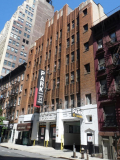
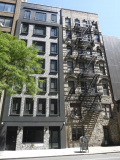
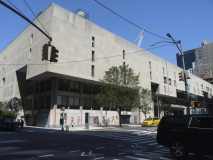
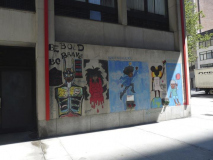
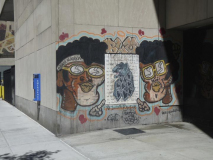
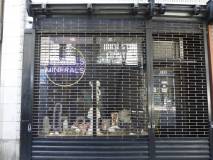
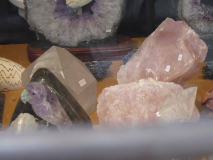
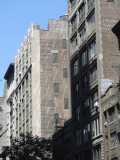
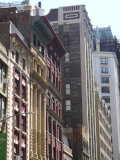
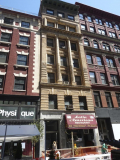
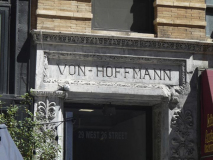
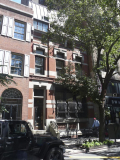

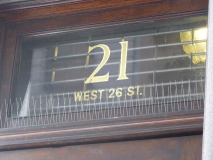


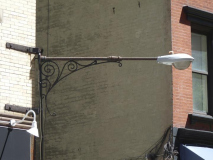
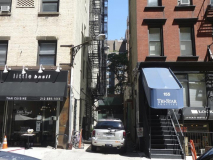
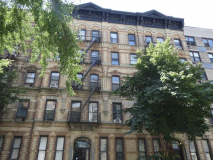
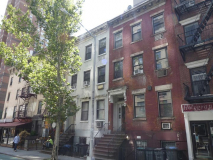
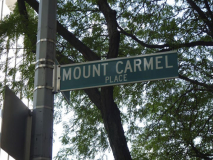
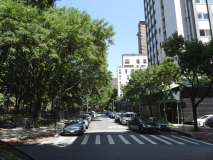
4 comments
The Armory is quite a building. I was excited when they started having concerts there. In the summer of 1994 Soundgarden played there. I got tickets, drank a lot at a bar on Park Avenue South just before the show, showed up ready to rock, and…found that the place was sweltering, with barely an adequate fan for cooling or ventilation. You could actually see waves of heat and steam coming off the tightly packed crowd. I realized within 5 minutes that I would die if I stayed there. So I left before the band came on. The concert has been bootlegged and it is not surprisingly called The Armory Show.
The carfloat and tracks that are visible were owned by the B&O and led to their adjacent terminal, which happens to be the site of the Dept. of Sanitation repair building shown
I’d like to also add that the “massive storage building” was the B&O’s freight terminal office/warehouse building, built in 1913. The Dept. of Sanitation repair building was constructed in 1994 — quite far removed from the 1930s.
I like the banners. If u r trading via mobile (which I’m often doing) u didn’t see them before. Now u do.